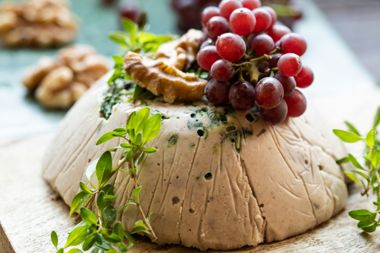
This dairy-free cheese has a deliciously salty and savoury taste with a rich, buttery texture from walnuts. The walnuts also give it a distinct but ever-so-mild flavour that makes it unlike any other cheese. Even if you’re not a fan of walnuts, I encourage you to buy some high-quality raw walnuts from the refrigerated section in your local health food store.
Walnuts also offer high amounts of omega-3 fatty acids, which your body needs to protect your brain, maintain a healthy immune system, balance moods, and reduce pain and inflammation in your body. Walnuts are also a good source of vitamins B6 and E as well as minerals like magnesium and potassium.
This recipe takes only about 10 minutes of actual preparation time, but the flavours are superb when the walnuts are allowed to culture for a day. Of course, you can culture it for less time if you simply can’t wait to enjoy your next batch. It is delicious on its own, or you can cut it into disks and serve it with your favourite crackers, grapes, or figs. Alternatively, spread it on freshly toasted bread, and savour the rich flavour as it slowly melts from the warmth. Mmmm.
Choosing cheese moulds
You can use just about any type of preferred container you want as a cheese mould, thereby giving your cheeses a wide range of shapes and sizes. There are professional cheese moulds available, but there is no need to use them with these types of cheeses, as most have small holes in them that simply don’t work well with the cheeses in The Cultured Cook. Simple Pyrex, glass, or ceramic bowls will work fine.
To help you choose the correct size of mould to use, here’s what I typically use:
- 2 cup (472 mL) Pyrex bowl for small blocks of cheese
- 1 quart (952 mL) for medium to large blocks of cheese
But don’t feel confined to use only round moulds. If you have square or rectangular containers that hold about the same amount, then feel free to use them.
Walnut Thyme Cheese
Ingredients
- 1 cup (250 mL) raw, unsalted walnuts
- 1/4 cup (60 mL) filtered water
- 2 capsules probiotics or 1/2 tsp (2 mL) probiotic powder
- 1 tsp (5 mL) extra-virgin olive oil
- 3 - 2 in (5 cm) sprigs fresh thyme, plus a few more for garnish (optional)
- 1 tsp (5 mL) unrefined sea salt
- 1/2 cup (125 mL) coconut oil
Directions
01
In a small glass or ceramic bowl, combine walnuts and water. Empty the contents of the probiotic capsules (discarding the empty capsule shells) or the probiotic powder into the bowl, and stir to combine. Cover and let sit in a warm, undisturbed spot for two days.
02
In a small frying pan over low to medium heat, sauteu0301 olive oil and thyme until sprigs are lightly crisped (about 3 to 5 minutes). Remove from heat. Once cool, pull thyme leaves off the sprigs, and sprinkle across the base of a small glass dish.
03
Pour the walnut mixture into a blender, add salt and coconut oil, and blend until completely smooth; pour into the glass dish coated in thyme leaves. Refrigerate, uncovered, until set (about 4 hours). Gently remove the cheese from the glass bowl, and serve upside down so the thyme leaves are on the top of the cheese. Garnish with thyme sprigs, if desired. Walnut Thyme Cheese keeps in the refrigerator, covered, for about 1 month.





